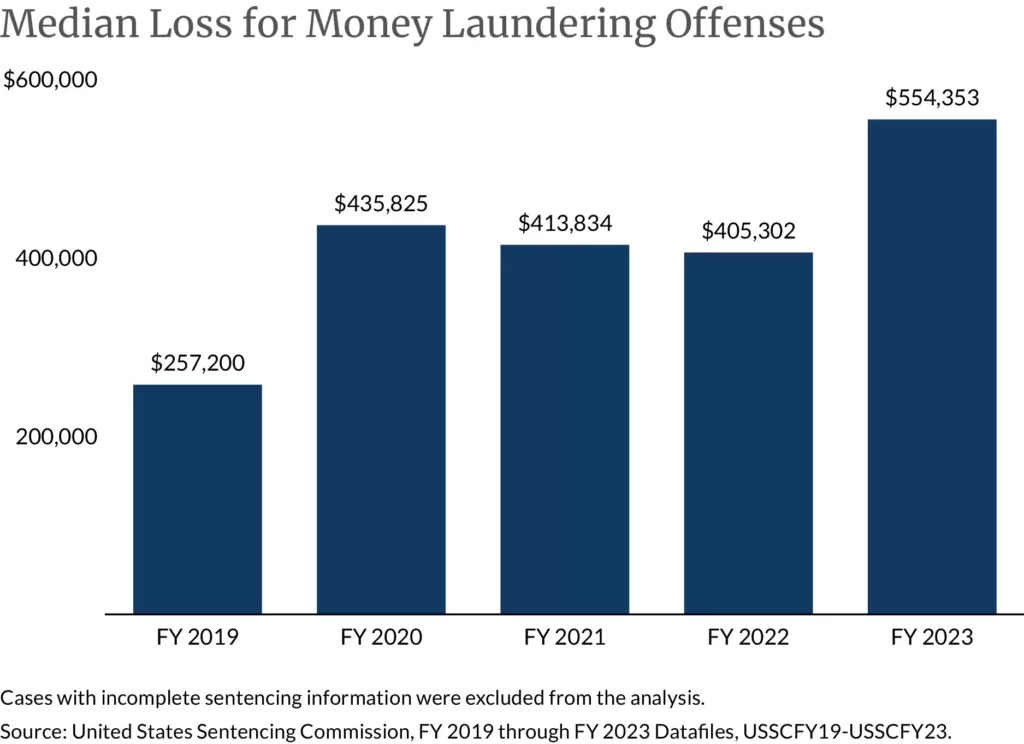Breaking Down the New AML/CFT Rules– Overview, Comparison, Scope, and More
September 10, 2024
6 minutes read
The US Government’s Financial Crimes Enforcement Network (FinCEN) proposed new rules for the AML and CFT on July 3rd, 2024. The rules aim to improve the state of recording and reporting of suspicious transactions with financial institutions.
The proposed rules seek to promote enhanced due diligence. effectiveness, efficiency, innovation, and flexibility.
According to the United States Sentencing Commission, the median loss for money laundering offenses stood at $554,353 for 2023.

As you can see from the graph, these proposed rules bring countermeasures against illegal financial transactions at an important time as money laundering losses expand. Now, let’s look at the acts that are closely related to FinCEN’s new proposed AML and CFT rules.
What are the Acts Relevant to these Proposed AML/CFT Rules?
There are two primary acts that the new rules revolve around. They are:
- The Bank Secrecy Act (BSA): It is also known as the Currency and Foreign Transaction Reporting Act, and was enacted in the year 1970. The Act authorizes the Secretary of Treasury to enforce reporting and recording obligations on banks and other financial institutions to monitor suspicious transactions. A transaction is said to be suspicious if it can be reasonably connected to money laundering, terrorism, or any other illegal activity.
- The Anti-Money Laundering Act (AML): The AML Act is a component of the William M. Mac Thornberry National Defence Authorization Act (NDAA) and was enacted in January 2021. The existing Act was based on standards that were decades old and didn’t take current, sophisticated AML requirements into account.
It was this existing aged standard that needed to be updated which led to the proposal of the new rules.
Objectives of FinCEN’s New Rules
The proposed AML rules intend to reassess and “strengthen, modernize, and improve” the record-keeping and reporting requirements for financial institutions. These are how the proposed rules will go about achieving these goals:
- Increase focus on the risk-based approach for Anti Money Laundering (AML) and Countering the Financing of Terrorism (CFT).
- Making the AML and CFT regulations more dynamic and responsive to the growing threat of money laundering and terrorism funding.
- Make the AML and CFT programs more in line with the purposes of the BSA.
- Make the AML and CFT programs to be more innovative to keep up with the changing digital environment.
Section-by-section Analysis of the Proposed FinCEN Rules
Here are the sections of the proposed rules and their intent:
-
Defining the purpose of the AML/CFT Program Requirements:
Section IV.A. covers this subject. The proposed statement is a new addition to the Act, but it does not create new obligations for financial institutions, monetary or otherwise. The contents of the section are intended to summarise the umbrella of functions that the proposed rules will cover.
-
Introducing the term “CFT”:
Section IV.B. inserts the term CFT into the purview of the program rules. This will lead to a change in the definition of the AML/CFT program. The definition states that the AML/CFT program is a system of internal policies, procedures, and controls. These are meant to ensure ongoing compliance with the BSA, and the requirements and prohibitions of 31 CFR Chapter X. They also intend to prevent an institution from being used for money laundering, terrorist financing, or other illicit finance activity risks.
The proposed rule would also replace parallel terms like “anti-money laundering program” and “compliance program” with the new AML/CFT term as described before.
-
Detailing the Priorities of the new AML/CFT Programs:
Section IV.C. lists out the priorities of the proposed programs. The previous instance of AML/CFT priorities was enforced on June 30, 2021. The AML/CFT priorities focus on threats to the US financial system and national security. FinCEN has proposed adding the new AML/CFT priorities to help with the publication of the new regulations.
After consulting with the relevant national agencies, FinCEN needs to update the AML/CFT Priorities once every four years. This is to ensure that the prescribed programs keep up with the changing financial ecosystem.
-
Listing the Components of the New AML/CFT Programs:
Section IV.D. describes the components that would lead to an “effective risk-based, and reasonably designed AML/CFT program”. The components include:
- a risk assessment process
- internal policies, procedures, and controls
- a qualified AML/CFT officer
- ongoing employee training
- periodic independent testing
- other components, depending on the type of financial institution
Effect of FinCEN’s Proposed AML/CFT Rule on Online Verification
It is clear that FinCEN has enhanced due diligence in mind while implementing these new AML and CFT rules. However, with new regulations come a ripple effect on businesses.
In order to be able to meet the more dynamic requirements of the proposed rules, businesses will have to improve the state of their personal verification methods. These improvements will take place in the form of better KYC and document verification processes.
Adapting to these new regulations would be a breeze though, thanks to Signzy’s variety of APIs that help in streamlining personal verification and KYC processes.
Takeaway of the Proposed AML and CFT Rules
As mentioned before, the pain point for the US financial system was the outdated nature of the existing money laundering and terrorism financing countermeasures. This pain point is what led to the proposition of the new rules.
The proposed AML/CFT rules aim to bring enhanced due diligence and improve the state of transaction recording/surveillance and reporting of suspicious transactions. The idea is to keep up with the evolving technology in the financial ecosystem. The new rules also aim to improve the scope of the umbrella that covers suspicious transactions, to ensure that newfound methods of illegal financial activities don’t pass under the Government’s radar.
Note: These are the proposed rules by the US Department of Treasury’s FinCEN. The final approved rules and their implications might differ in the future.
- Learn about the AML and CFT acts. The older versions of the act try to enforce recording and reporting of financial transactions that might be suspicious in nature.
- The new rules aim to modernize the recording and reporting mechanism. The new rules also try to improve the state of reporting regarding suspicious transactions.
- Understanding the implications of the new rules on businesses and changes in reporting norms.













